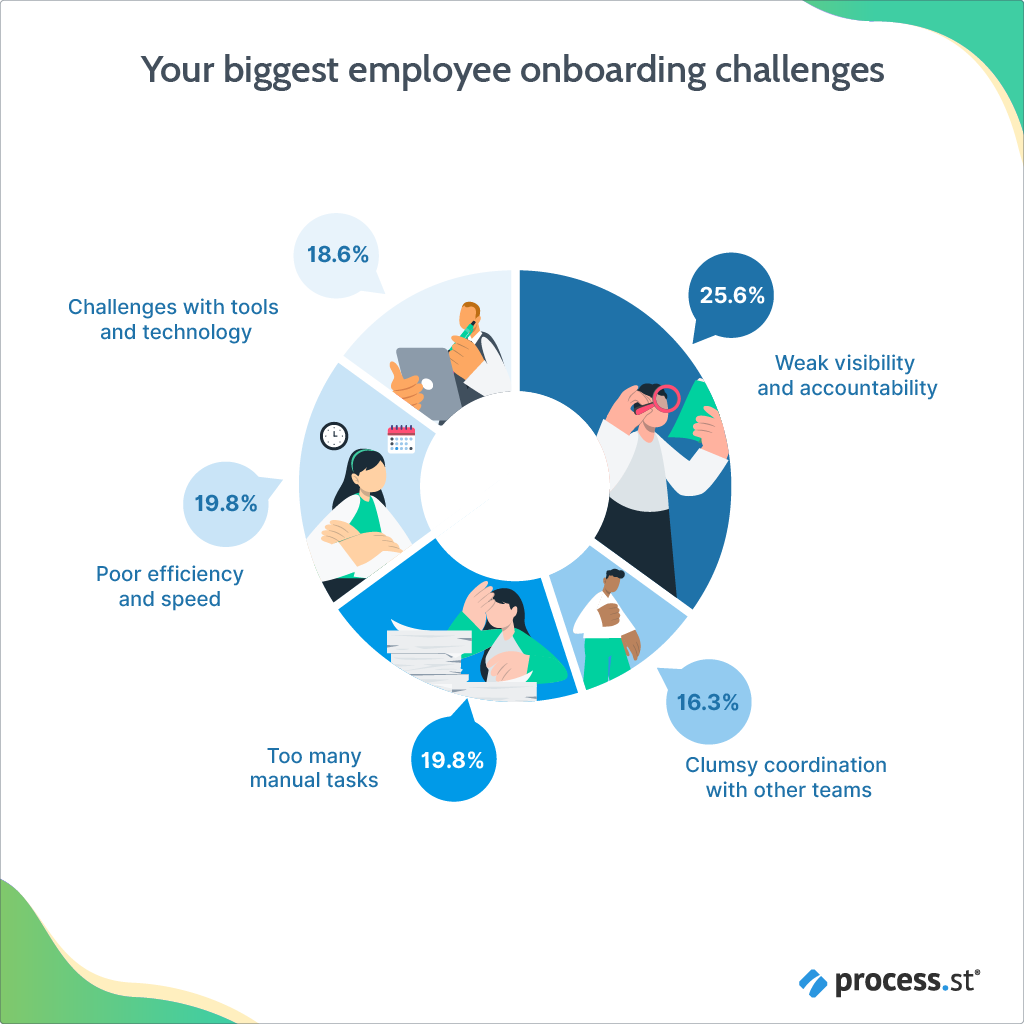
At the recent HR Transform Conference, we had the opportunity to ask about your biggest employee onboarding challenges. What did our Process Street survey say?
- 25.6% said weak visibility & accountability
- 19.8% said too many manual tasks
- 19.8% said poor efficiency & speed
- 18.6% said challenges with tools & technology
- 16.3% said clumsy coordination with other teams
Want to know how to make new hire onboarding less of a pain? Keep reading!
25.6% said weak visibility & accountability
More than a quarter of HR managers we surveyed experience weak visibility and accountability during the employee onboarding process.
Weak visibility breeds low accountability due to the number of things that slip under the radar. How does weak visibility manifest itself?
Our results showed:
- Lack of understanding around the onboarding workflow for employees using the template;
- Difficulty tracking new hire’s progress;
- Lack of transparency and no/few updates between meetings;
- No centralized information;
- Low employee engagement.
Overall, 25.6% of you have weak visibility, making it difficult to maintain accountability throughout the new hire onboarding process.
What does that mean?
Lack of accountability can lead to mistrust, working as a domino effect causing worker devaluation, low engagement, and reduced productivity.
How we can help shed some light
Workflow management software – Like Process Street – helps improve the weak visibility and accountability
While analyzing our survey results, we found tons of comments about too much information in different locations.
“No centralized information.”
Onboarding a new employee requires a lot of documentation. Before you know it, the process becomes a chaotic mess.
Process Street is one of the workflow management tools that keeps everything together in one centralized knowledge hub.
“Lack of understanding around the onboarding workflow for employees using the template.”
When running your Process Street onboarding workflow, you have the complete process laid out in front of you. Everyone can see the relevant tasks to complete so there’s no confusion.
“Low employee engagement.”
Role assignments allow you to assign each stakeholder to their specific tasks within the process. Everyone is clear about their responsibilities throughout the onboarding process.
A lack of understanding is one of the common causes of low employee engagement. Providing increased transparency is an easy way to avoid this issue from the beginning.
“Difficulty tracking new hire’s progress.”
Once a Process Street workflow is run, you can see the progress of it from your dashboard.
You can also set dynamic due dates for tasks you need approved by a specific date. You’re notified if these tasks are overdue, helping reduce the risk of a bottleneck occurring.
“Lack of transparency and no/few updates between meetings.”
Notes are usually taken during a meeting, but it’s communicating them that’s the issue.
Likewise, once the HRM signs off, what’s to make sure updates actually happen between the meetings? How many meetings have we had where everyone settled on a plan and then forgot because other things derailed plans? Or ended up getting sidetracked by other topics instead of what the focus should be?
How does a workflow ensure constant accountability?
- Regular check-ins could be scheduled and generated on Google calendar along with a Zoom link to the call.
- A check-in/update workflow could be triggered with a future due-date so the manager would get the new workflow when it was time to do an update.

19.8% said too many manual tasks
Employee onboarding is vital – we know this. But we also know that there’s a lot that needs to be done to prepare for a new hire and even more tasks to integrate the employee into the company culture.
That’s why it’s no surprise that many of the HR professionals we surveyed claimed that:
- There were too many to-dos;
- The manual process reduced productivity;
- It’s difficult to find time to build a great program;
- Consistency and automation were challenging to achieve;
- Sending reminder emails to collect forms was time-consuming;
- There were too many checklists in too many places;
- Capacity was reduced.
Here’s what to do
If it’s difficult to find the time to build a good onboarding program, you can use a pre-made onboarding template instead. This helps cover all the bases in your onboarding program and you can edit it to add anything you might specifically need for your organization.
Organizations often rely on multiple apps for their onboarding process but this quickly results in siloed data.
Automations can be used to pass that data to and from other apps, reducing the amount of manual copy-pasting needed to do. Not only does this help you keep information in one place, but it also reduces errors and helps you become more efficient as a result.
19.8% said poor efficiency & speed
Our survey results showed that HR professionals experience two main issues with onboarding efficiency.
The first is lacking a centralized knowledge base. Necessary information isn’t readily available so onboarding speed and efficiency goes down.
More concerning is the fact that many HR departments don’t have an onboarding process at all. 12-35% of companies haven’t created a formalized onboarding program.
Start streamlining
Using workflow Automations saves time by limiting the number of recurring tasks you need to perform. Instead, you can focus your attention on building rapport with your new hire.
Process Street’s integrations will make your onboarding program fun, fast, and faultless by streamlining your business with process automation.
18.6% said challenges with tools & technology
18.6% of HR professionals at the HR Transform Conference believed their biggest onboarding headache was because of challenges with technology and tools.
Some of the most common issues were:
- Too many systems to update;
- Confusion around where to find answers.
Without the right understanding of onboarding tools and technology, new hires and employers can’t optimize their efforts. Instead, the onboarding experience can feel confusing without any clear direction of how the new employee can achieve success.
No-code simplicity
Process Street is designed as a no-code software. That means you can easily build, customize, and optimize your workflows without encountering any confusion.
The no-code functionality means complex training programs aren’t necessary. With the support of our comprehensive resource library and intuitive design, anyone can create, update, and run onboarding templates in minutes.
16.3% said clumsy coordination with other teams
Inter-departmental coordination is key to onboarding. Clumsy coordination with other teams will not only leave your new hire feeling a little confused, but potentially very frustrated as well.
Now, how can you make sure you’re giving your employees the best onboarding experience if you have clumsy coordination with other teams? Exactly! You can’t.
A whopping 16.3% of our HR professionals at HR Transform believe this to be their biggest challenge. Subsequently, they also stated that they suffer from:
- Lack of communication and clear process;
- Connecting employees to culture;
- Getting employees engaged with new hires on top of their jobs;
- Information overload.
Get everyone involved in the process
You can assign users and groups to tasks in your workflow runs. This gives them responsibility for those tasks. So, if you’re having a difficult time with cross-department coordination, you can make a group with the responsible team.
One of the benefits of this is that anyone in the group/department can complete the task. For example, an HR department needs to send tax forms. Assign “HR department” as a group and anyone in the HR department can complete that task whereas if the task is assigned to a specific person, only that person can complete it.
When a workflow is run with these task assignments, they will be sent an email notification informing them that they have been assigned and that those tasks are ready to work on. Everything these teams need should be included in the task. That way you can prevent information overload.
What did you think of our survey results? Do you deal with any of these issues as an HR manager? Let us know in the comments!







 Workflows
Workflows Forms
Forms Data Sets
Data Sets Pages
Pages Process AI
Process AI Automations
Automations Analytics
Analytics Apps
Apps Integrations
Integrations
 Property management
Property management
 Human resources
Human resources
 Customer management
Customer management
 Information technology
Information technology



Grace Donaldson
Grace is a content writer with a thirst for knowledge and coffee. You'll find her reading in a small café or singing at a rundown jazz bar when she's not overconsuming coffee or compartmentalizing her thoughts into a blog post.